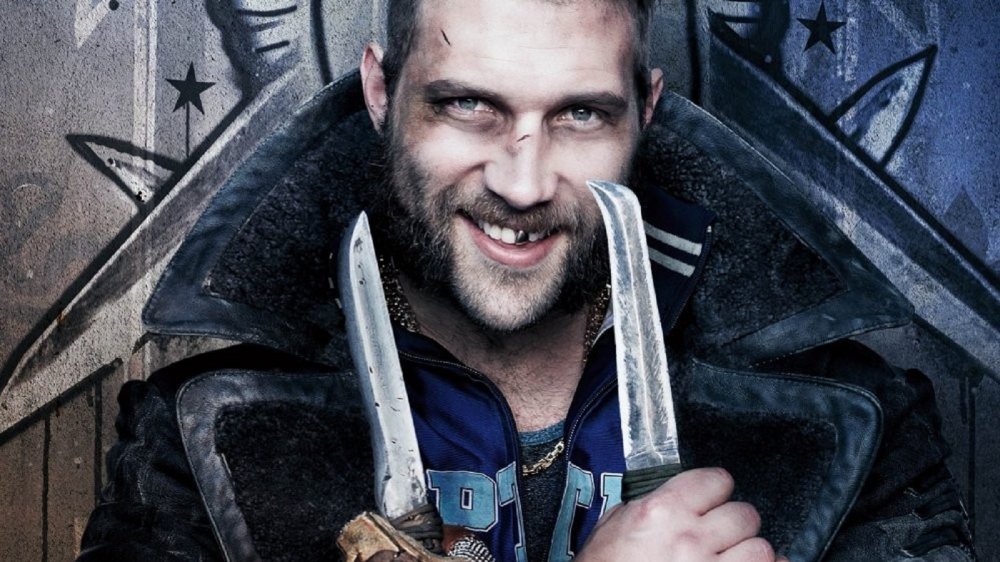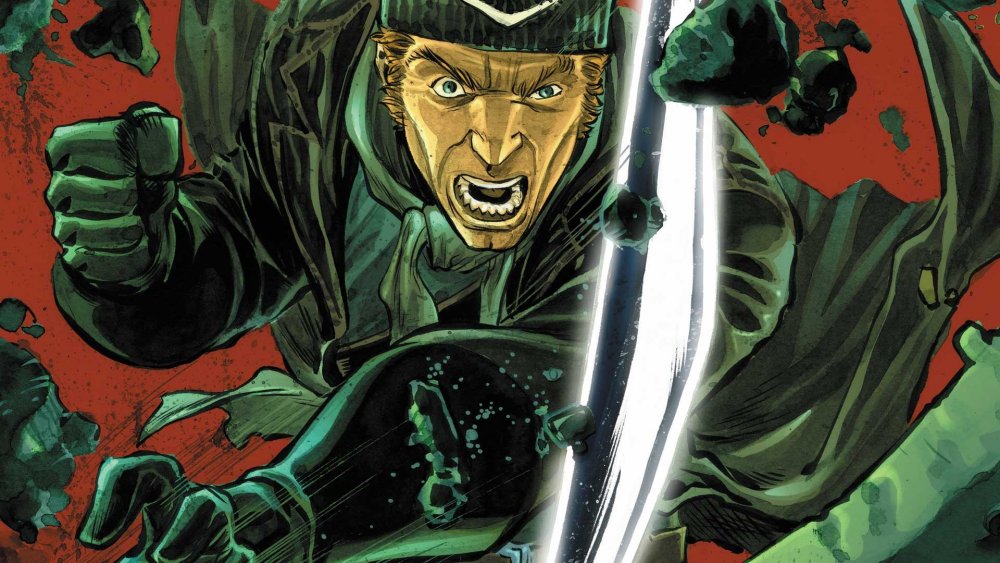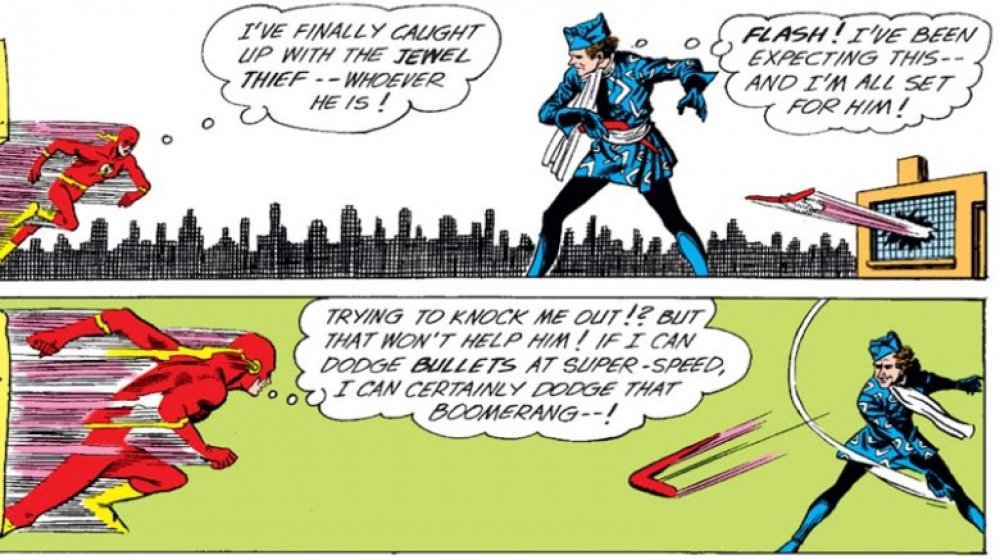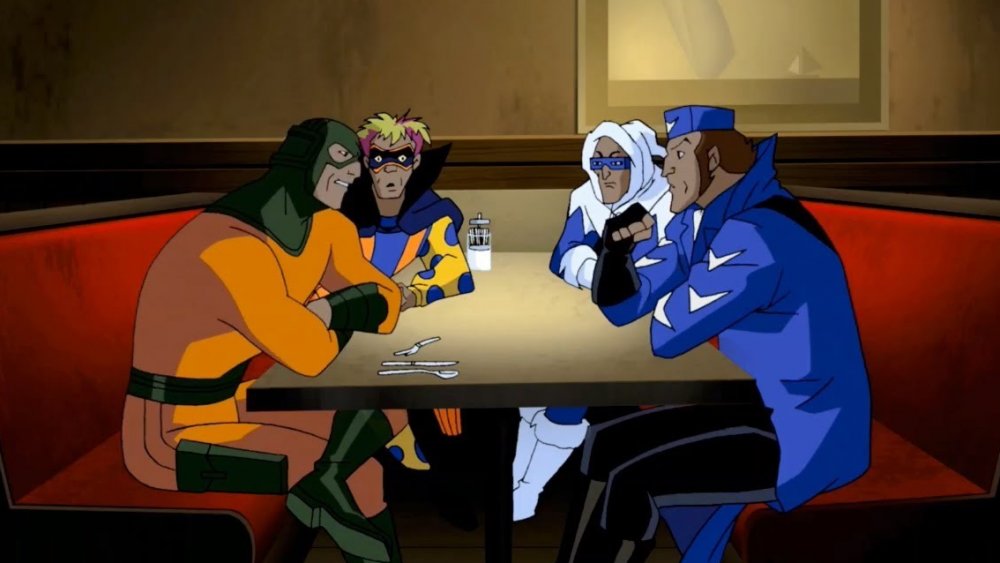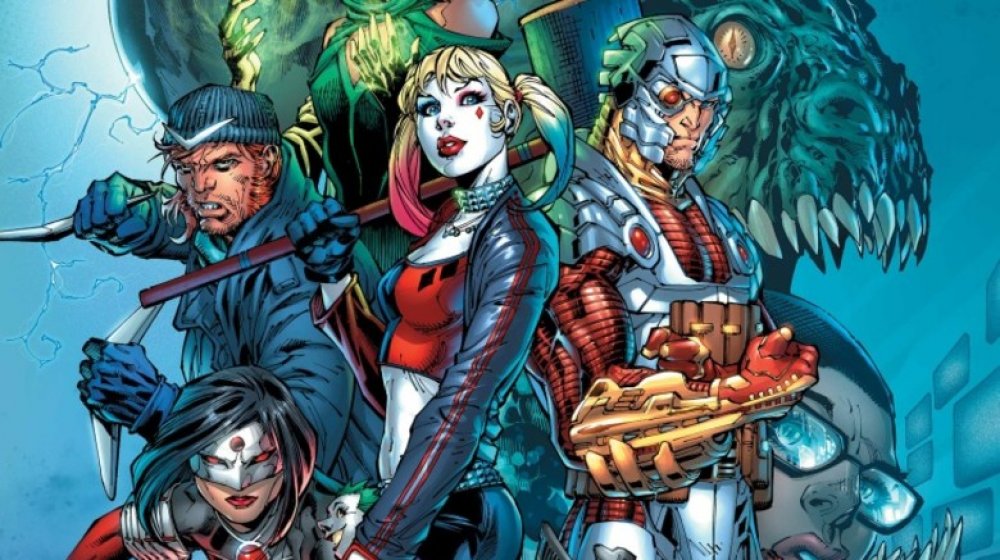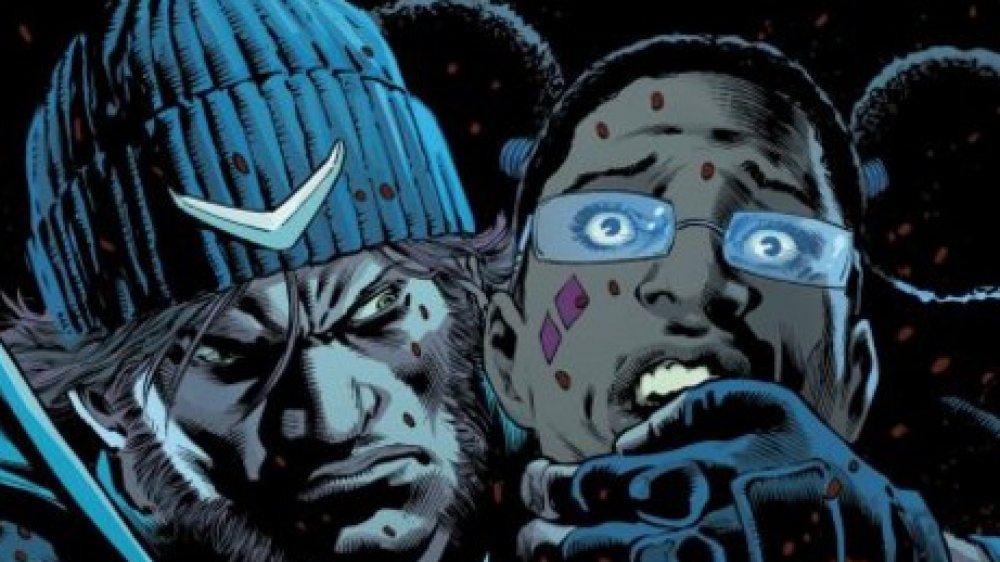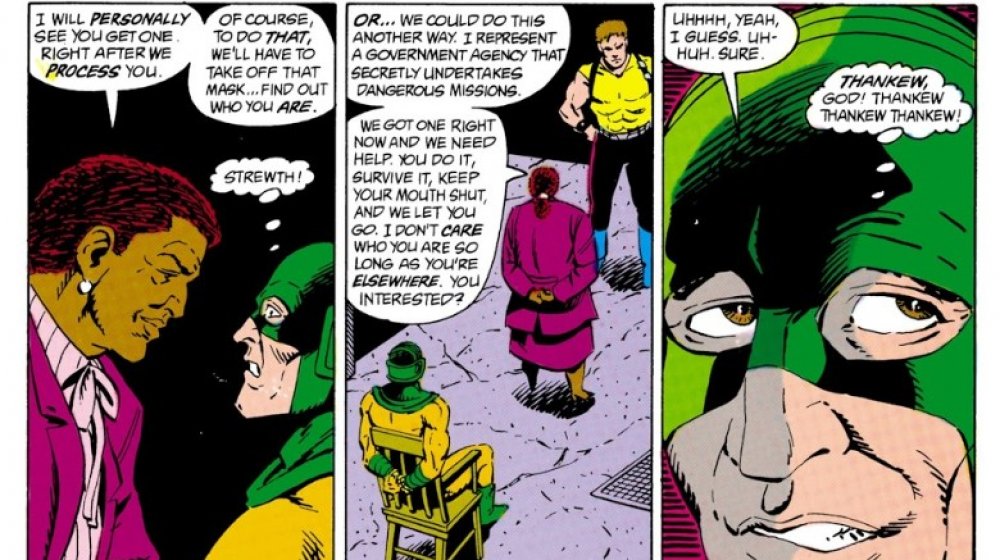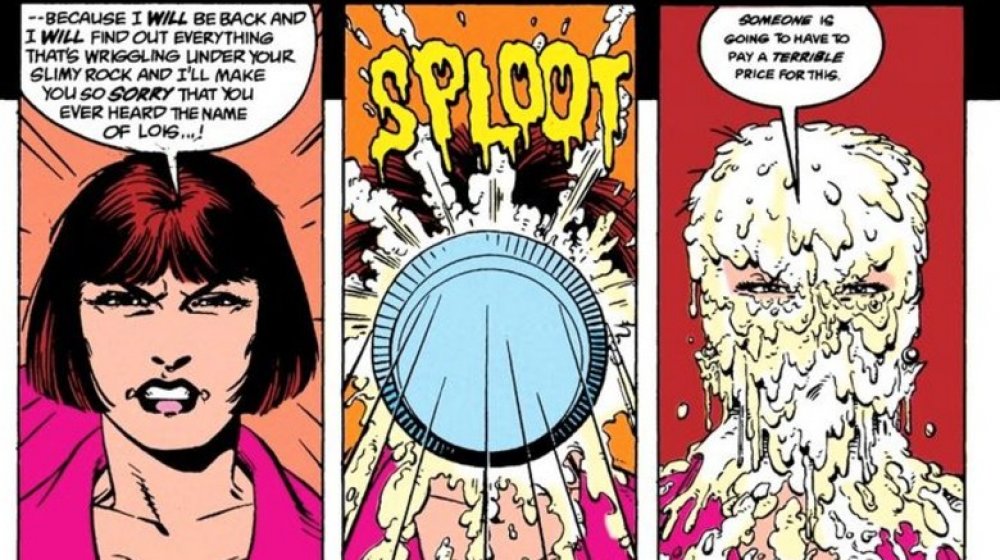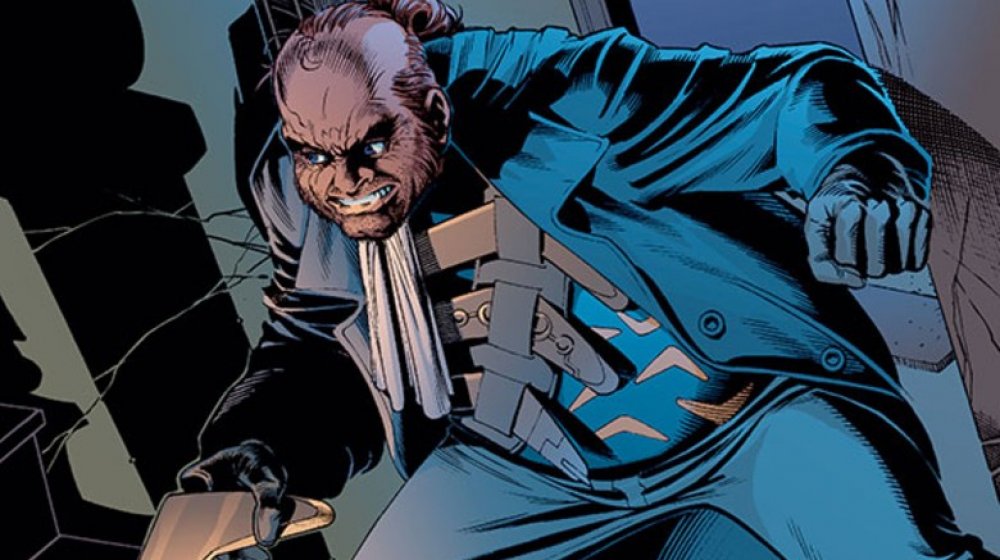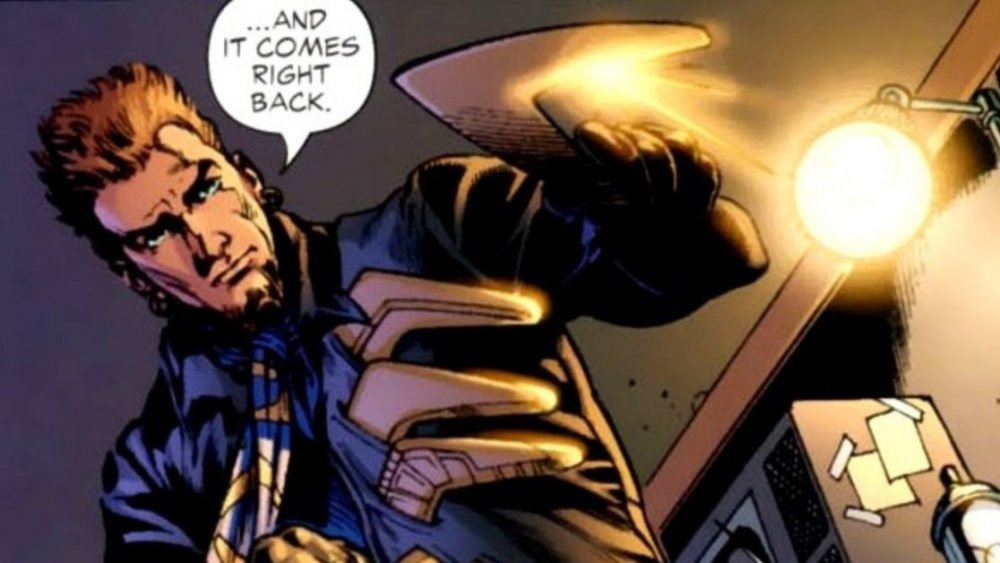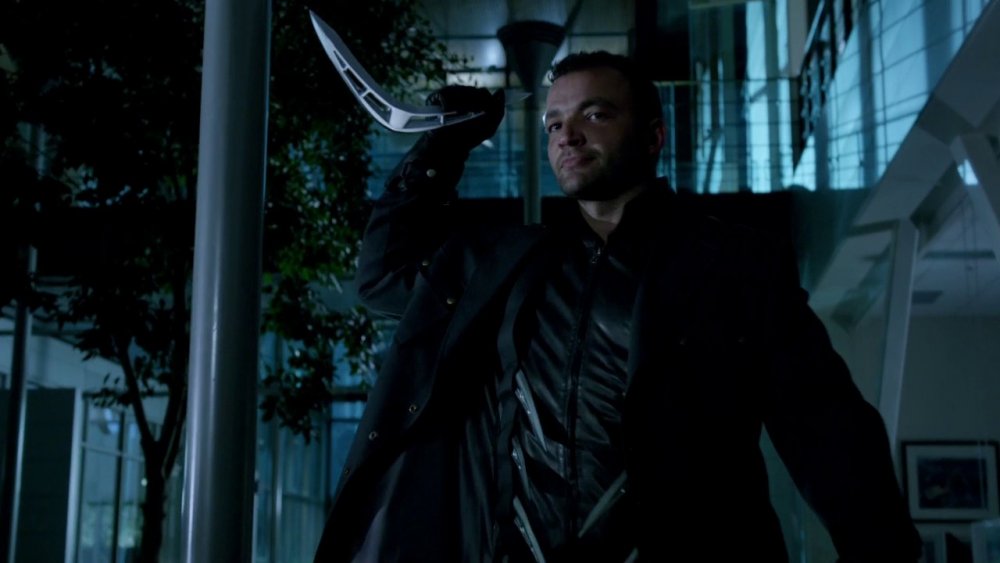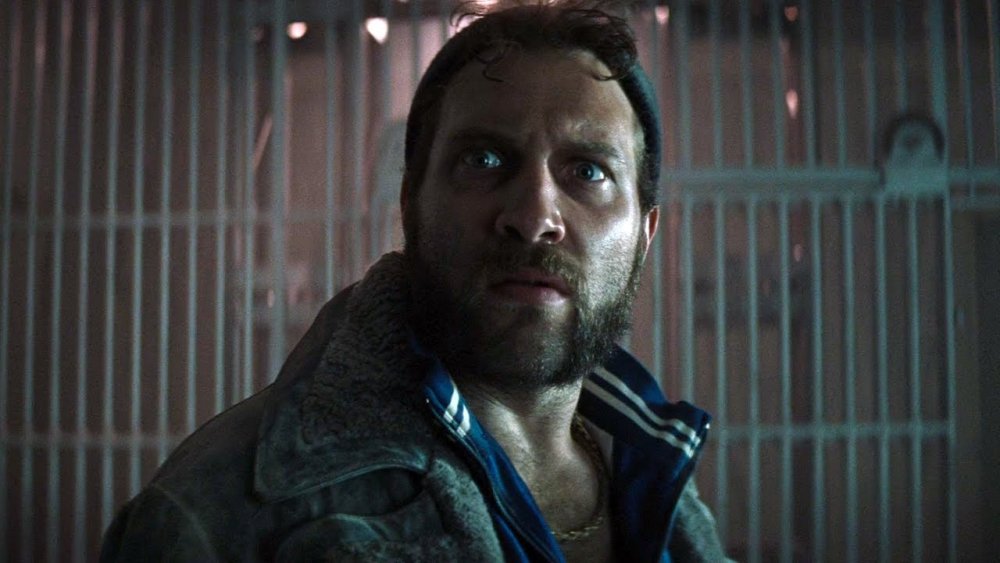DC's Supervillain Captain Boomerang Explained
He isn't the most famous, and he certainly isn't the most heroic, but one of the most singular super guys to show up in the DCEU is Digger Harkness, better known as Captain Boomerang — though his colleagues in the Suicide Squad know him better as simply Boomer.
Captain Boomerang first arrived in the DC comics of the '60s, mostly acting as one of the Flash's Central City bad guys. But like so many comic book characters, Captain Boomerang has evolved quite a bit. The dastardly rogue's nationality has changed, he's made indelible marks on some of DC's most memorable teams, and he's been a part of groundbreaking DC events. Along with his appearances in comics, animated series, films, and video games, actors have brought Digger Harkness to life in both television and on the big screen.
To learn about how this nasty baddie went from being a rogue to one of the most recognizable antiheroes in DC's fictional universe, keep reading for Captain Boomerang explained.
Who is Captain Boomerang?
Who is Captain Boomerang? The short answer is that he's a shameless crook who will do just about anything to make a buck. He doesn't boast any supernatural abilities. Instead, he carries an arsenal of boomerangs that he wields with lethal skill. Predictably, Boomer's weapons aren't just run-of-the-mill boomerangs. Some are rigged with explosives, some can cut through throats, and some can electrocute.
While he acts as a lone wolf in his earliest appearances, as time wears on, Boomer becomes more of a team player, even though he's never very good at getting along with whatever team he's in. He's joined forces with the other prominent villains of the fictional Central City, and more famously, he's one of the villains often pressed into service for the United States government by the tyrannical Amanda Waller.
Digger Harkness isn't the most patient of men. He has a short temper and can turn on his allies with little provocation. Sadly, he's also not shown himself to be a particularly forward-thinking guy. Particularly in early appearances of the Suicide Squad comic, Digger regularly makes racist and sexist comments about his teammates. A native Australian, Digger sees himself as a patriot to his homeland, though ironically, readers would eventually learn that — because of his criminal exploits — most of his countrymen are ashamed of him.
Captain Boomerang, then and now
Captain Boomerang first locks horns with Central City's guardian speedster, the Flash, back in 1960's The Flash #117. While the rogue's blue, white, and black costume wouldn't change much between that first appearance and Captain Boomerang's more prominent appearances in the '80s, in other ways, he changes quite a bit.
In Flash #117, Digger Harkness gets the idea to become Captain Boomerang when the W.W. Wiggins Game Company starts searching for a mascot who can promote their toy boomerangs. Harkness is already a thief at that point, and he uses his unique boomerang talents help him in his battles with the Scarlet Speedster. He's initially able to defeat Flash with one of his lightning boomerangs. He then ties the unconscious Flash to a giant boomerang and shoots it into the ocean, but predictably, Flash escapes and puts an end to the crook's plans.
In most of his earlier appearances, Captain Boomerang seems just as goofy as many of his contemporaries. But interestingly, it isn't specified in his early days that Digger Harkness is from Australia. The country isn't mentioned at all, and his dialogue isn't written to reflect that nationality.
Captain Boomerang and the Rogues
What do you do once you've created enough villains designed to go after a specific superhero? You bring them all together in a team, of course! In the case of Flash's villains, bringing together the speedster's bad guys creates the Rogues — one of the most enduring groups of villains in the history of DC Comics.
Captain Boomerang is one of the founding member of the Rogues. He's there in 1962's The Flash #130 to join forces with contemporaries like Trickster, Captain Cold, the Top, and Mirror Master against their common enemy. Over the years, more bad guys like Heat Wave and Weather Wizard would join, and just about any villain who spent enough time taking their lumps fighting the Flash would find their way to the Rogues. In some cases, the Rogues have almost stepped into more heroic territory. Along with taking down scores together and combining forces against the Flash, every now and then, the group stands against other villains whose actions against Central City jump across the kind of moral lines the Rogues won't cross.
While Boomer is one of the first bad guys to count himself among the Rogues, eventually he becomes less and less associated with the group as his destiny takes him to a very different collection of bad guys.
He's a regular in the Suicide Squad
Boomer is a regular fixture in the modern version of Task Force X, aka the Suicide Squad. He's part of the group in their very first battle against Brimstone in 1987's Legends #3 and appears regularly in all of the subsequent volumes of Suicide Squad. He's part of the team in the Justice League Unlimited episode "Task Force X," as well as in 2014's Batman: Assault on Arkham, 2018's Suicide Squad: Hell to Pay, and 2020's Justice League Dark: Apokolips War. He'll be there for the upcoming video game Suicide Squad: Kill the Justice League, was part of the team in CW's Arrowverse, and of course, he was played by Jai Courtney in 2016's Suicide Squad.
Ironically, in spite of how often he works with Task Force X, Boomer's one of the most disliked members of the team. He butts heads with just about all of his teammates, especially fellow Squad regulars Deadshot and Bronze Tiger. He also makes sure to be a constant thorn in the side of the Squad liaison Amanda Waller, who takes to referring to him as "Boomerbutt."
It's surprising how often Boomer finds himself working for Waller, considering what a pain he can be to everyone involved. On the one hand, you could say it's a testimony to his effectiveness in battle that his presence continues to be tolerated. On the other hand, the fact he keeps getting caught by law enforcement in the first place doesn't speak well of his skills.
You don't want to be on a team with Captain Boomerang
Hypothetically, if you ever had to be in the Suicide Squad, Boomer is just about the last guy you'd want to team up with. While Captain Boomerang's portrayal changes a bit depending on who's writing him, one thing that tends to remain consistent is that he has no problem with backstabbing his teammates.
Boomer betrays one of his colleagues in one of the team's earliest adventures. In 1987's Suicide Squad #1, tired of listening to Boomer mock other team members, Mindboggler uses her powers to reveal Boomer's biggest fears. In the following issue, Boomer sees that Mindboggler is about to be gunned down from behind by the villain Rustam. He whips out a boomerang to intervene but stops himself, remembering how Mindboggler humiliated him. He then escapes as Rustam shoots and kills Mindboggler.
In 1988's Suicide Squad #9, Boomer betrays a teammate by using him as a something of a test subject. Boomer isn't sure his superiors mean it when they threaten to detonate the explosives strapped to the squad members' arms, so he convinces Slipknot that they're bluffing. After a heated battle, Slipknot tries to escape the squad, and he pays with his life when he learns the explosives are all too real.
Boomer's treachery isn't just part of his early portrayals with the squad. In 2017's Suicide Squad #13, Boomer murders fellow teammate Hack by stabbing her with one of his boomerangs. So yeah, he's not exactly what you'd a call nice guy.
Captain Boomerang makes an interesting reflection
One of the upsides of being a bad guy in the world of costumed heroes and villains is that it makes the notion of disguising yourself that much simpler. For example, when Marvel's Masters of Evil want the world to think they're heroes, they just change their costumes to become the original version of the Thunderbolts. In one of Suicide Squad's earlier memorable subplots, Captain Boomerang tries a similar trick ... with not as much success.
Boomer's service on Task Force X earns him some perks. While his freedom is still dependent on doing what Amanda Waller says, Boomer is allowed to live outside the walls of the Belle Reve prison, provided he doesn't commit any crimes. Refraining from crime is too tall an order for Digger Harkness, so he works out a creative way to make some scratch without drawing attention to himself. While he's not on Task Force X missions, Boomer steals while dressed as Mirror Master, another Central City Rogue.
Boomer's plan works fine ... until it doesn't. In 1988's Suicide Squad #20, he's captured by the vigilante Manhunter while dressed as Mirror Master and, ironically, winds up in Belle Reve where Waller recruits him as Mirror Master. When Waller sends both Boomer and Mirror Master on a mission and the crook tries his best to keep up the gag, he learns Waller knew what he was doing the whole time. He loses his apartment, and he's sent back to his Belle Reve prison cell.
The Pie Man of Belle Reve
Of the many things that distinguish Captain Boomerang from other characters, the foul-tempered crook is behind one of the funniest and longest subplots in the history of Suicide Squad comics.
In 1988's Suicide Squad #21, Amanda Waller is walking about Belle Reve prison and considering her recent challenges when a whipped cream pie flies into her face. Suspecting Boomer is the culprit right away, Waller has him summoned, and on his way to see her, a pie gets him in the face. It would take three years for the pie-thrower to be revealed. In 1989's Suicide Squad #26, Vixen gets a pie in the face while getting frisky with Bronze Tiger, and Bronze Tiger gets one a moment later. Both Daily Planet reporter Lois Lane and Nemesis take a dessert to the nose in Suicide Squad #23, and Jewelee and Doctor Light fall victim to the sweet, creamy attacks in the following issue.
The final pie victim is Major Victory in 1990's Suicide Squad #37. Boomer tries to frame fellow squad member Punch by filling his locker with pies, but he's found out regardless. It's discovered Boomer used his boomerang tech to get himself in the face, throwing suspicion off himself early. Boomer quits the squad, laughing in Waller's face that there's nothing she can do to punish him. In a pretty extreme example of going far to prove someone wrong, Waller has Boomer helicoptered to a deserted island and left there.
The death of Captain Boomerang
In 2004, DC Comics released the game-changing miniseries Identity Crisis. The story unfolds with the violent death of Sue Dibny, wife to superhero Ralph Dibny, aka the Elongated Man. What follows is a mystery that explodes in many different threads, including a series of shocking reveals involving misdeeds committed by DC's heroes. One such thread includes Digger Harkness accepting a high-profile job that leads to his death.
Identity Crisis finds Captain Boomerang having fallen on hard times. He can hardly rub two pennies together, and among DC's community of supervillains, he doesn't command the respect he once did. In Identity Crisis #5, Boomer embarks on what proves to be his last job — the murder of Jack Drake. While he doesn't have any super powers or fancy gadgets, Jack Drake is no standard mark. Jack is the father of Tim Drake, the Robin of the time. Terrified his sidekick will have to experience what he suffered when his parents were murdered, Batman rushes to Jack Drake's home once he learns of the murder attempt, but he's too late. Drake mortally wounds Boomer with a handgun, but not before one of the villain's boomerangs likewise kills Drake.
Predictably, Digger Harkness would eventually find his way back to the land of the living, but not before someone else took over the mantle of Captain Boomerang.
The son of Captain Boomerang
Before his death in Identity Crisis, Digger Harkness connects with his grown son, Owen Mercer. Mercer not only inherits his father's talent with boomerangs, but he's capable of bursts of super speed. After Boomer is killed on his final job, Mercer becomes the new Captain Boomerang.
Mercer's early career as Captain Boomerang has a lot in common with his late father's. He begins working with the Rogues, and he eventually joins the Suicide Squad. Unlike his father, Mercer actually finds his way into a group of bona fide heroes, as he enjoys a turbulent time with Nightwing and the Outsiders.
It's ironic Mercer manages to reach levels of heroism his father never could because, ultimately, his actions would reach even lower than those of Digger Harkness'. During the 2009-10 DC Comics line-wide event Blackest Night, like many of DC's heroes and villains, Digger Harkness is reanimated as an undead beast. And then the Rogues discover that Mercer has been feeding innocent civilians to Harkness in a futile attempt to return him to normal. Enraged that his fellow Rogue has acted so abominably, Captain Cold shoves Mercer into a pit with his undead father, who subsequently rips his son's heart out.
The Arrowverse's Captain Boomerang
A couple of years before the Suicide Squad film, Captain Boomerang (Nick E. Tarabay) made his live-action debut in season 3 of The CW's Arrow. In the series, he shows up in the final moments of "Draw Back Your Bow" and gets a lot more screen time in "The Brave and the Bold" when he tears through A.R.G.U.S. agents in his quest for revenge. We learn that Digger is a former Suicide Squad agent whose last mission didn't go as planned. Once things went sideways, Lyla Michaels (Audrey Marie Anderson) opted to activate the bombs implanted in all Task Force X recruits' necks, but apparently, the device in Digger malfunctioned.
"The Brave and the Bold" is one of the earliest team-ups between Oliver Queen (Stephen Amell) and the Flash (Grant Gustin), and it's clear Team Arrow could use the back-up. Digger proves to be just as formidable an enemy as his comic book counterpart, though eventually, Queen and the Flash take him down. Captain Boomerang appears one more time in season 5's "Lian Yu" when Queen releases Digger and Deathstroke (Manu Bennett) from their island prisons to help him defeat Prometheus (Josh Segarra). Proving just as treacherous as his comic book counterpart, Digger is revealed to have already made a deal with Prometheus. But Harkness doesn't survive to regret his choice, as he's killed by Malcolm Merlyn (John Barrowman), who willingly sacrifices himself by purposely detonating a land mine when Harkness approaches.
The Captain Boomerang of the big screen
Jai Courtney brings Digger Harkness to life on the big screen with 2016's Suicide Squad. Courtney's portrayal of Digger Harkness brings a lot of humor to the action-packed film, and it's clear Courtney and the filmmakers drew heavily from the source material. Still, there are some significant differences between the comic books and movie.
Like the Captain Boomerang of the comics, Digger starts his criminal career as a Flash villain. Ezra Miller cameos as the Scarlet Speedster, capturing Digger in a flashback. And just like the source material, Courtney's version of Digger can't stand Amanda Waller (Viola Davis). The film adapts Digger's manipulation of Slipknot into unintentionally killing himself from 1988's Suicide Squad #9. Also, we see early on that like his comics counterpart, Courtney's Boomer prefers to avoid fighting. When the rest of the squad first clashes with the strange creatures in Midway City, Digger hangs back and cracks open a beer, only engaging when he has no choice.
There are important differences between Courtney's Digger and the source material, however. He's overall less nasty to his teammates, ultimately shows himself to be much more of a team player, and in particular, he comes off as a lot tougher than the comic book version. For example, when guards release him from a body bag, Digger immediately stands up and attacks the nearest guard. That's something the comic book Digger would probably never do unless he already had his boomerangs on him because, otherwise, the guard might hit him back.
